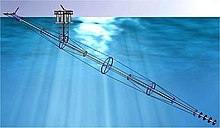
A space gun, sometimes called a Verne gun because of its appearance in From the Earth to the Moon by Jules Verne, is a method of launching an object into space using a large gun- or cannon-like structure. Space guns could thus potentially provide a method of non-rocket spacelaunch. It has been conjectured that space guns could place satellites into Earth's orbit (although after-launch propulsion of the satellite would be necessary to achieve a stable orbit), and could also launch spacecraft beyond Earth's gravitational pull and into other parts of the Solar System by exceeding Earth's escape velocity of about 11.20 km/s (40,320 km/h; 25,050 mph). However, these speeds are too far into the hypersonic range for most practical propulsion systems and also would cause most objects to burn up due to aerodynamic heating or be torn apart by aerodynamic drag. Therefore, a more likely future use of space guns would be to launch objects into Low Earth orbit, at which point attached rockets could be fired or the objects could be "collected" by maneuverable orbiting satellites.[citation needed]
In Project HARP, a 1960s joint United States and Canada defence project, a U.S. Navy 410 mm (16 in) 100 caliber gun was used to fire a 180 kg (400 lb) projectile at 3,600 m/s (12,960 km/h; 8,050 mph), reaching an apogee of 180 km (110 mi), hence performing a suborbital spaceflight. However, a space gun has never been successfully used to launch an object into orbit or out of Earth's gravitational pull.